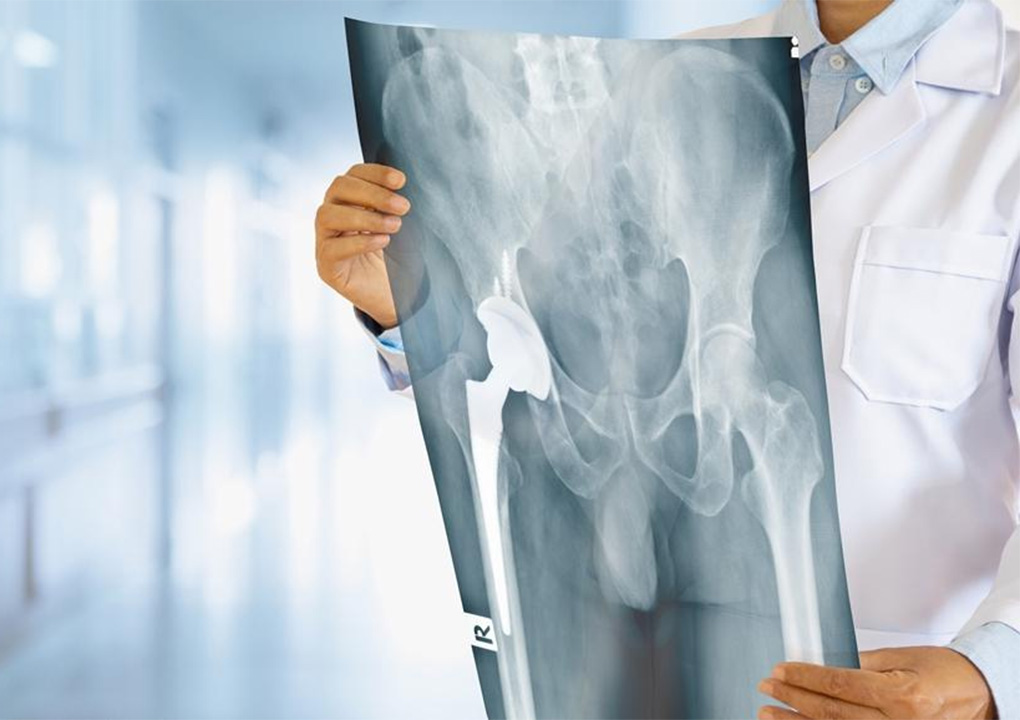Hip Replacement Surgery
Hip replacement surgery is a procedure where an orthopaedic surgeon surgically removes a painful hip joint and replaces it with an artificial joint often made from metal and plastic components. The new joint aims to reduce pain and improve functions of the affected hip.
If you have arthritis in the hip, common activities such as walking, climbing stairs may be painful and uncomfortable. The hip can be stiff and it is often difficult to wear socks and clip to nails. Your family will notice the waddle in your walking gait and at times, it can even be uncomfortable while resting or sleeping. Because hip arthritis gradually worsens over time, the earlier you start treatment the more likely you can reduce the impact it has on your life and daily activities. Although there is no cure for arthritis, there are many different treatment options available to help manage the problem.
You will want to consider a hip replacement if other treatment options have not been or are no longer effective in managing the problem. Hip replacement is a safe and effective procedure that can relieve your pain, improve the motion and help you get back a better quality of life and enjoying normal daily activities.

A total hip replacement on the left
What is Arthritis?
Arthritis is inflammation of the joints. Any joint in the body can be affected but it is most common in the weight bearing joints such as the hips and the knees. In the hip, the most common symptoms are pain, stiffness and a reduction in motion. Arthritis makes it difficult to perform everyday activities including walking and climbing stairs and even clipping of the toe nails. It is a serious disability in many people.
What are the type of Arthritis?
There are many different types and causes for arthritis. The more common ones are listed below.
Osteoarthritis
Rheumatoid Arthritis
Rheumatoid arthritis is a form of Inflammatory Joint Disease. It is an autoimmune disease where the body’s immune system attacks and destroys the normal tissue in the hip and softens the bone. This is usually a chronic disease and affects multiple joints throughout the body. The same joint on both sides are usually affected.
Arthritis in the hip after injury or Post Traumatic Arthritis
This is a form of arthritis that develops after an injury to the hip, usually fractures or dislocations. These injuries are increasingly common in Singapore due to higher numbers of injuries in sporting activities and road traffic accidents. These injuries can cause the cartilage in the joint to be damaged resulting in the development of arthritis.

Avascular Necrosis or AVN
This is a group of conditions in the hip that is the result of a “vascular insult”. What this means is that the bloody supply to the head of the femur reduced and cut- off, causing damage. The hip bone then collapses and deforms. Common causes include injuries such as fractures and dislocations of the hip. Certain diseases can also cause avascular necrosis of the hip.
Hip dysplasia and childhood hip problems
Some children have problems in their hips. Although most of these problems are identified early and treatment started, problems of arthritis can still develop later on in life. This can happen as the hip joint might not develop and grow normally or the joint surfaces are affected as part of the disease process.
What happens during hip replacement surgery
During hip replacement surgery, the damaged joint is surgically removed and replaced with the hip prosthesis.
- The damaged femoral head is removed and the metal prosthetic stem is inserted into the hollow or centre of the femur bone. The implant is cemented or “press fit” into the bone canal. (Picture 1,2,3)
- A metal or ceramic ball is placed on the upper part of the femur stem. The ball replaces the damaged femoral head (Picture 2).
- The damaged acetabulum or hip socket is the removed and replaced with a metal socket (Picture 2).
- A plastic or ceramic spacer is inserted inbetween the new ball and socket to allow for a smooth gliding surface for the hip joint.
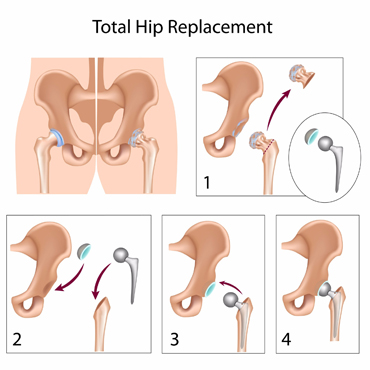
How long do these implants lasts?
Based on historical data, most hip implants will last 15- 20 years with moderate use.
When would you consider having a Total Hip Replacement?
Having a total hip replacement is an important cooperative decision made between yourself, your family and your orthopaedic surgeon. There are many reasons why you may be recommended for a total hip replacement and most patients who have benefited from this type of surgery often have:
- Severe hip pain or stiffness such that walking, climbing stairs and daily activities become difficult. Simple tasks such as wearing of socks or clipping of toe nails become difficult or even impossible.
- Pain in the hip causing weakness and even back aches.
- Having pain at rest during the day or in the night. Getting out of bed after waking in the morning will be difficult.
- Pain and stiffness that does not improve significantly with medications or rest.
Suitability for Surgery
There are no absolute age restrictions for hip replacement surgery. Recommendations for surgery are based on the individual patient’s condition and on their general health state. Most patients who undergo such surgeries are between the ages of 60-80 but such surgeries are successfully performed at all ages.
Orthopaedic Examination in the Clinic
When you consult the doctor, he will gather information about your medical history and specific details about the condition of your hip. He will also examine your hips to assess the condition including the motion, areas of tenderness and overall leg alignment.
X-rays of the hips are commonly done to determine the degree and extent of damage and deformity in the knees. Other tests such as an MRI (magnetic resonance imaging) scan or blood tests may be required to further assess the condition of the joint.
The orthopaedic doctor will discuss and explain the results of the evaluation and discuss the treatment options available. He will also advice if a total knee replacement is the best option to treat the arthritis in your knees.
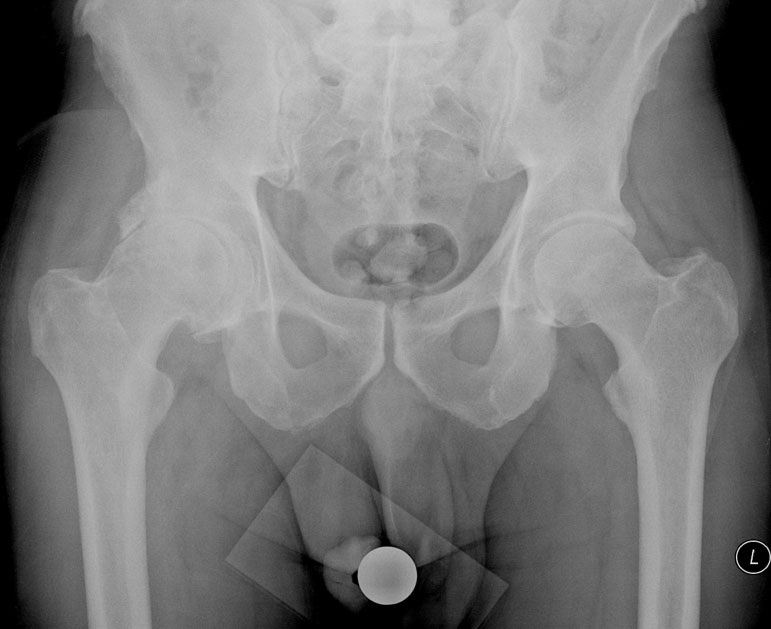
Xrays of both hips showing severe arthritis of the right hip
Expectation after Surgery
Understanding what a total hip replacement can and cannot do for you is an important factor in deciding whether to have surgery.
Most patient who have undergone a total hip replacement experience a remarkable reduction in hip pain and ability to perform normal daily activities. A period of post-surgical rehabilitation with physiotherapy is needed. It is important to note that a total hip replacement will not be able to allow you to do more than what you could do before you developed arthritis.
The hip implant is an artificial joint. It is prone to wear and tear with use. With moderate use, the hip implant can last for as long as 20 years. Excessive activity or high impact activities can speed up the wear in the joint and cause the implant to loosen and pain in the hip. This is why most orthopaedic surgeons advice against participating in high impact activities after a hip replacement. Low impact sports and activities such as biking, swimming, walking, tai chi is more appropriate.
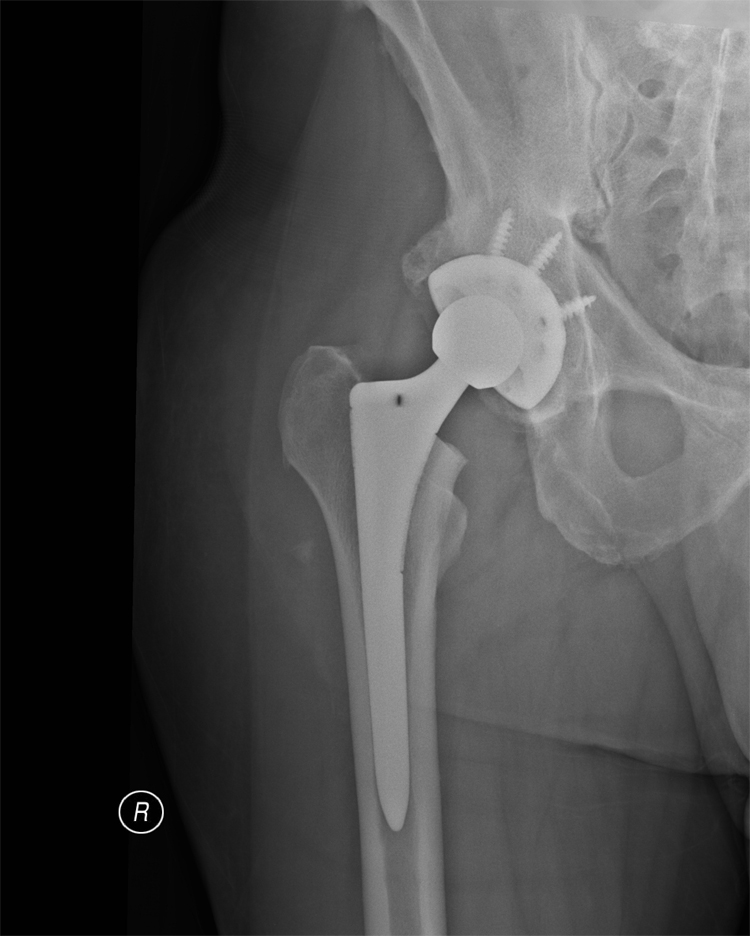
After a total hip replacement on the Right
Potential complications of Hip Replacement Surgery
A Total Hip replacement is major surgery. The success rate is high at 95%. Serious complications can happen and they happen in less than 2% of patients. Those suffering from chronic illnesses or have a poorer state of general health can be at increased risk of potential complications. It is important to discuss these with your doctor and understand their significance and impact before deciding on surgery. The more important ones are listed below.
Infection
The incidence of infection happening after hip replacement surgery is at 1%. Infection can be superficial at where the wound is or deep around the implant and prosthesis. This can happen while you are still in hospital or after you go home. It can even occur a few years later. Superficial infection can often be treated with wound dressing and antibiotics. Deep infections often require surgery to control and treat the infection. At times, the prosthesis may need to be removed and re- inserted at a later time once the infection is settled. Any infection in your body can spread to the knee replacement. Dr Lee’s advice to patients when visiting the dentist is to inform him or her that they have had a hip replacement done and that they need to take prophylactic antibiotics as a precautionary measure.
Implant wear and loosening
The design of the total hip replacement implant and the biomaterials used have gone through significant improvements over the years. They are more anatomic, have a better range of motion and lasts longer than earlier versions. However, the lifespan of such implants is still finite and surfaces will wear down over time and with use. Appropriate modification of activities can allow the implant to last up to 20 years. High impact or high intensity activities can result in accelerated wear and premature implant failure.
Blood clots in the veins
Blood clots in the veins are common after hip replacement surgery. They are also known as deep vein thrombosis and are similar to “economy class syndrome”. These clots can be dangerous if they break free and travel to the lungs. When this happens, it is called a pulmonary embolism. Dr Lee has an established program to reduce the possibility of this occurring, including early onset of lower limb exercises to improve blood circulation, the use of compression stockings and medications to thin your blood.
Neurovascular Injury
Injuries to the nerves and blood vessels are rare but can happen during surgery. The sciatic nerve is a huge nerve at the back of the hip joint. Injury to the nerve can result in a foot drop, which causes the foot and the toe not to be able to point up. This usually improves in 3 months.

The course of the sciatic nerve runs posterior (behind) to the hip joint
Limb Length Inequality
It is common for patients with severe osteoarthritis of the hip to have inequality in the length of the legs. The affected leg is usually shorter due to the disease process. During a hip replacement, the surgeon will aim to restore the length of the legs to be even, but may lengthen or shorten the leg slightly to maximise the stability and biomechanics of the artificial hip. It is more common for patients to feel that the leg after surgery is longer because it has been “restored” to normal! Some patient may feel more comfortable with a shoe lift after surgery, but this is not commonly needed.
Dislocation of the hip
This is when the ball of the hip comes out of the socket. Dislocation risk is low, but is the highest in the first 3-4 months after surgery while the tissues and muscles are healing. To avoid such problems, the surgeon and physiotherapist will educate you on the “at risk positions” which you need to avoid and work on a rehabilitative program to strengthen the hip. Should a dislocation occur, the hip can usually be “put back” without the need for surgery.
What activities should I avoid after surgery?
Pivoting or twisting on the involved leg should be avoided between 6 to 12 months after surgery. You should also not cross the involved leg past the midline of the body nor turn the involved leg inward and you should not bend at the hip past 90 degrees. This includes both bending forward at the waist and squatting. On a more practical note, care should be taken while wearing trousers, socks and shoes. Special devices are available if needed.
Your physical therapist will provide you with techniques and adaptive equipment that will help you follow any of the above guidelines and precautions while performing daily activities. Remember, by not following your therapist’s recommendations you could dislocate your newly replaced hip joint and may require another surgery.

This is a strict “no- no”!
Recovery after a hip replacement
After hip replacement, you will start physiotherapy on the first day after surgery. This involves exercises to put the hip through a gentle range of motion and walking with a walking aid or a pair of crutches. Over the next few weeks, the physical therapist will take you through an activity program which will include a graduated increment for walking, strengthening exercises and functional training such as walking up and down stairs and other house hold activities.
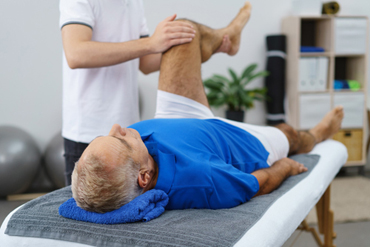
Physiotherapy working on mobility exercises for the hip and knee
To make your home safer after surgery, it might be easier if the following improvements can be made:
- Avoid stairs and create a total living area on a single floor. For most patient, moving the bedroom to the ground floor would be sufficient.
- Consider installation of safety bars and handrails in the shower and toilet.
- Remove loose rugs and carpets.
- Have a footstool ready to elevate your leg.
- Avoid sitting on a low stool or low sofa.
At 6 weeks after surgery, you can generally resume most daily activities such as shopping and light housekeeping. Driving is also possible at that time, if you have developed good muscle control and motion in the hip.
Once you have recovered, you can look forward to enjoy a variety of low impact activities without problems. Currently, more than 90% of hip replacements are still functioning well at 15years after surgery. Following the doctor’s advice and instructions after surgery and taking care of your hip and general health are important ways to contribute to the success of your surgery.

